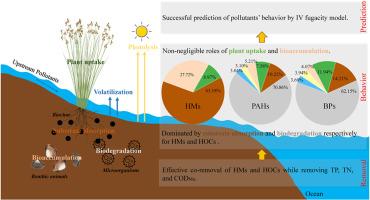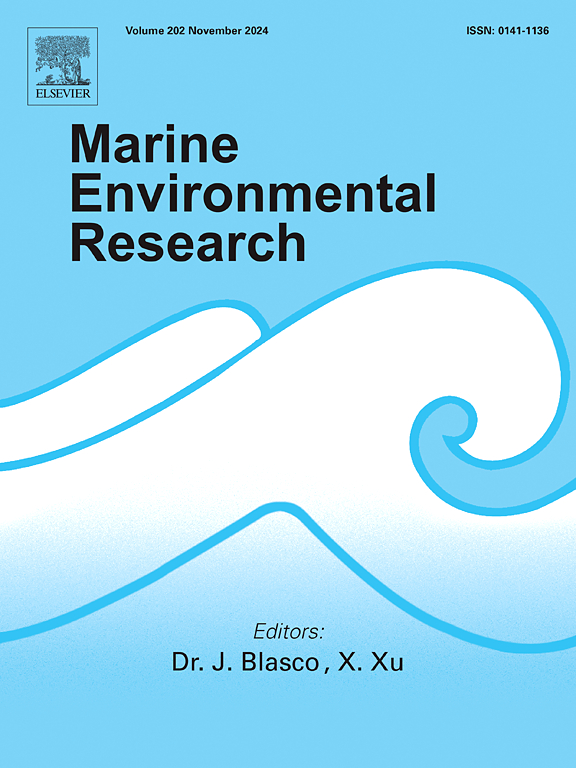潮流湿地中重金属和疏水性有机污染物的归宿分析:对污染特定生态修复策略的见解
IF 3.2
3区 环境科学与生态学
Q2 ENVIRONMENTAL SCIENCES
引用次数: 0
摘要
滨海湿地在调节生物地球化学循环和衰减人为污染物方面发挥着重要作用。然而,对湿地截流上游污染物效能的量化研究却很少。本研究建立了模拟上海南汇东滩湿地水动力条件的实验室规模潮汐流湿地(TFWs),以评价其对多种污染物的协同去除效果。结果表明:化学需氧量(CODMn: 0.45 g/m2/d)、总氮(TN: 0.38 g/m2/d)、总磷(TP: 0.051 g/m2/d)、铅(Pb: 3.50 mg/m2/d)、镉(Cd: 0.71 mg/m2/d)、Σpolycyclic芳烃(ΣPAHs: 1023.64 μg/m2/d)和Σbisphenol类似物(ΣBPs: 404.60 μg/m2/d)具有优异的复合污染物去除能力。行为分析表明,底物吸附(63.18%)是去除重金属(HMs)的主要途径,而生物降解(62.15-70.86)是去除疏水有机化合物(hoc)的主要途径。铁修饰的生物炭的引入显著增加了互变菌、Arcobacter和甲基噬菌的丰度,这些属在TFWs中表现出对hoc的特定降解能力。同时,植物吸收(7.58 - 11.94%)和底栖生物积累(4.07 - 5.21%)成为HMs和HOCs不可忽视的途径。因此,在以hm为主的NDW修复中,应优先进行底物修饰,而在以hoc为主的NDW修复中,底物修饰可与海荆芥(Scirpus mariqueter)种植相结合。IV级逸度模型可以准确预测不同污染物在沉积物-水-植物-生物群阶段的分配。然而,铁修饰生物炭的修正提高了沉积物-水分配系数(Ks),从而低估了与底物相关的hm。同样,根诱导的“铁斑块”增加了水生植物的生物积累因子(KG),导致水生植物中HOCs的浓度被低估。这些差异强调了水动力-生态耦合模型参数优化的必要性。本文章由计算机程序翻译,如有差异,请以英文原文为准。

Fate analysis of heavy metals and hydrophobic organic pollutants in tidal flow wetlands: Insights for pollution-specific ecological remediation strategies
Coastal wetlands play a critical role in modulating biogeochemical cycles and attenuating anthropogenic pollutants. However, limited attention has been paid to quantifying the efficacy of wetlands in intercepting upstream pollutants. In this study, lab-scale tidal flow wetlands (TFWs) simulating the hydrodynamic conditions of the Shanghai Nanhui Dongtan Wetland (NDW) were established to evaluate the synergistic removal efficiency of diverse contaminants. Results indicated exceptional composite pollutant removal capacities: chemical oxygen demand (CODMn: 0.45 g/m2/d), total nitrogen (TN: 0.38 g/m2/d), total phosphorus (TP: 0.051 g/m2/d), lead (Pb: 3.50 mg/m2/d), cadmium (Cd: 0.71 mg/m2/d), Σpolycyclic aromatic hydrocarbons (ΣPAHs: 1023.64 μg/m2/d), and Σbisphenol analogs (ΣBPs: 404.60 μg/m2/d). Behavior analysis demonstrated that substrate adsorption (63.18 %) dominated the removal of heavy metals (HMs), while biodegradation (62.15–70.86 %) was identified as the primary pathway for the removal of hydrophobic organic compound (HOCs). The introduction of iron-modified biochar significantly increased the abundance of Altericroceibacterium, Arcobacter, and Methylophaga, with these genera exhibiting specific degradation capabilities for HOCs in TFWs. Meanwhile, plant uptake (7.58–11.94 %) and benthic bioaccumulation (4.07–5.21 %) emerged as non-negligible pathways for HMs and HOCs. Therefore, substrate modification should be prioritized for HM-dominated scenarios in NDW remediation, while substrate modification could be coupled with Scirpus mariqueter planting in HOC-dominated scenarios. The Level IV fugacity model can accurately predict the partitioning of different pollutants across sediment-water-plant-biota phases. However, the amendment of iron-modified biochar elevated sediment-water partition coefficients (Ks), thereby underestimating the substrate-associated HMs. Similarly, root-induced “iron plaques” increased aquatic plant bioaccumulation factors (KG), resulting in underestimated concentrations of HOCs in aquatic plants. These discrepancies emphasized the need for parameter optimization in hydrodynamic-ecological coupled models.
求助全文
通过发布文献求助,成功后即可免费获取论文全文。
去求助
来源期刊

Marine environmental research
环境科学-毒理学
CiteScore
5.90
自引率
3.00%
发文量
217
审稿时长
46 days
期刊介绍:
Marine Environmental Research publishes original research papers on chemical, physical, and biological interactions in the oceans and coastal waters. The journal serves as a forum for new information on biology, chemistry, and toxicology and syntheses that advance understanding of marine environmental processes.
Submission of multidisciplinary studies is encouraged. Studies that utilize experimental approaches to clarify the roles of anthropogenic and natural causes of changes in marine ecosystems are especially welcome, as are those studies that represent new developments of a theoretical or conceptual aspect of marine science. All papers published in this journal are reviewed by qualified peers prior to acceptance and publication. Examples of topics considered to be appropriate for the journal include, but are not limited to, the following:
– The extent, persistence, and consequences of change and the recovery from such change in natural marine systems
– The biochemical, physiological, and ecological consequences of contaminants to marine organisms and ecosystems
– The biogeochemistry of naturally occurring and anthropogenic substances
– Models that describe and predict the above processes
– Monitoring studies, to the extent that their results provide new information on functional processes
– Methodological papers describing improved quantitative techniques for the marine sciences.
 求助内容:
求助内容: 应助结果提醒方式:
应助结果提醒方式:


